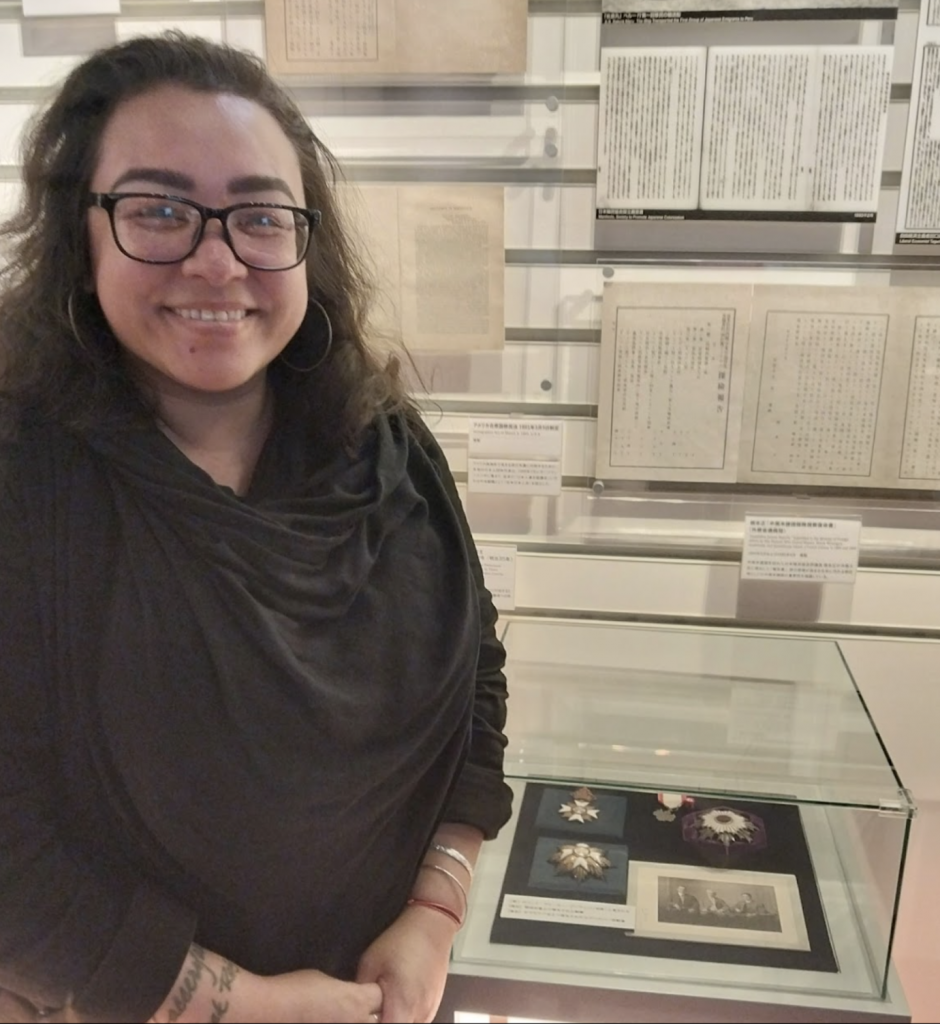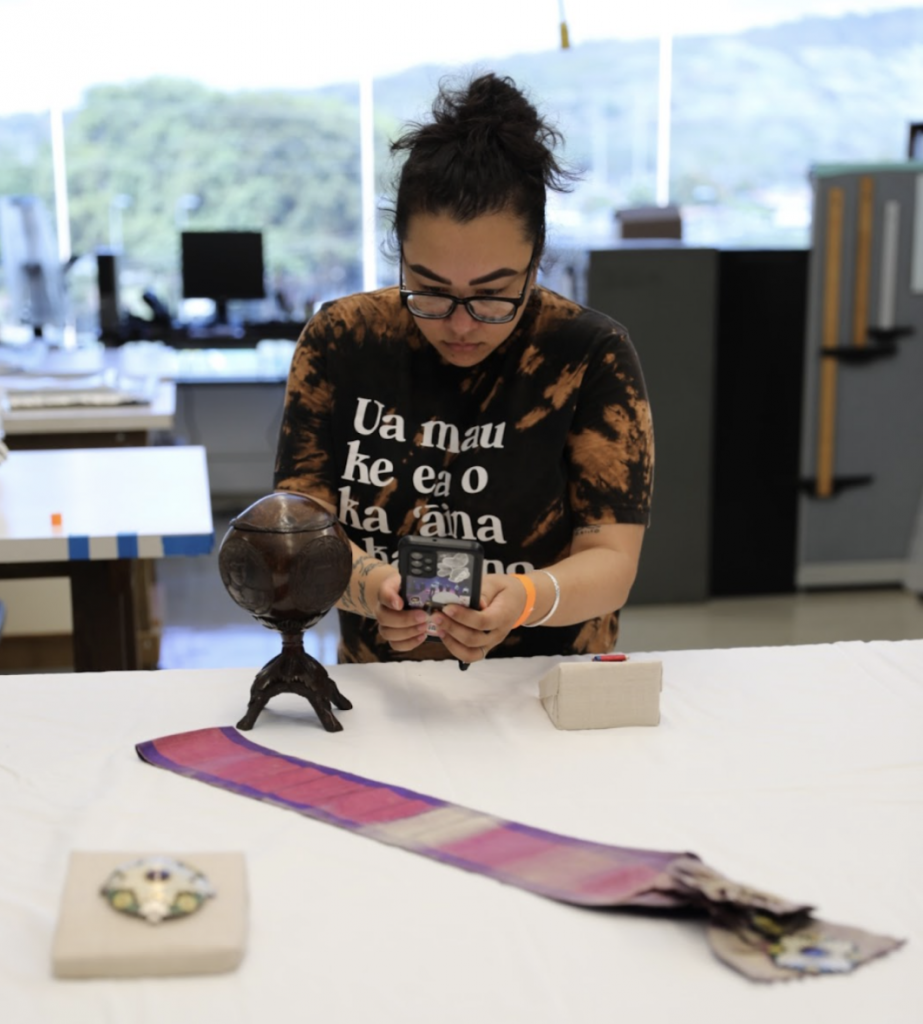Na Kikilia Lani (Doctoral Student, Educational Administration)
In 1881, King David La‘amea Kalākaua embarked on a ground-breaking mission to circumnavigate the world, determined to further elevate Hawai‘i’s global standing by bolstering economic ties abroad (Balutski, 2024, p. 291). Welcomed by eager dignitaries, he spent his nine-month expedition fostering diplomatic relations, examining foreign governance, and exploring immigrant labor as a means to support Hawai‘i’s economy (Sai, 2024, p. 479).
Kalākaua’s efforts resulted in powerful connections between Hawai‘i and the nations he visited; bonds forged through trade, immigration, and royal diplomacy– a skill mastered by our ali‘i. Traditionally, diplomacy included “ornamental” exchanges, with gifts like feathered cloaks, rare shells, hula, and mele serving as tangible expressions of pilina (McCreery, 2021, p. 221). Over time, these makana evolved to include European-influenced royal orders.
During a visit to ‘Iolani Palace, I learned that royal orders originated in medieval times when knights pledged loyalty to rulers and were honored with insignia (‘Iolani Palace, 2025). Over time, royal orders became symbols of elite status. It made perfect sense for Hawai‘i, newly-recognized in the Family of Nations, to adopt this practice. More than mere titles, royal orders quickly became instruments of Hawaiian statecraft, awarded to notable figures– both foreign and Hawaiian alike, to solidify alliances and acknowledge loyalty, demonstrating the kingdom’s diplomatic reach and desire to assert its presence on the world’s stage.
A Glimpse at Hawaiian Royal Orders:
Note: Two Hawaiian Royal Orders are not listed here– the Order of the Crown and Cross (1848) and the Order of Arossi (c. 1850). The former was never awarded, while the latter, the first to be conferred, was effectively “lost” due to political strife in the Solomon Islands (Gonschor, 2018, p. 56).
Royal Order of Kamehameha (1865)
Established by Kamehameha V to honor his grandfather, Kamehameha Pai‘ea, this order recognized exceptional service to the kingdom. The Collar of the Order was awarded only four times: twice by Kalākaua in 1881 (to Japan’s Meiji Emperor and Great Britain’s Queen Victoria) and twice in 1883 (to Tsar Alexander III of Russia and French President Jules Grévy) (Medcalf, 1963).
Royal Order of Kalākaua (1875)
Created by Kalākaua himself, this order recognized those who contributed to Hawai‘i’s growth. There were four classes of this order, but only two Grand Cross collars were made. Kalākaua gifted one of them to the Prince of Wales and allegedly kept the other for himself.
Royal Order of Kapiʻolani (1880)
Named after Queen Kapi‘olani, this order honored humanitarian service, particularly in the fields of health, science, art, and education. Kalākaua envisioned this as a way to inspire those working to revive and strengthen the Hawaiian nation after a significant population decline. Along with the Order of Oceania, it was one of two royal orders explicitly intended for women, though ali‘iwāhine also wore insignia from the Royal Order of Kamehameha I’s Knights Grand Cross on occasion (Medcalf, 1963, p. 8).
Royal Order of the Crown of Hawaiʻi (1883)
Awarded for military and political contributions, this order also commemorated Kalākaua’s coronation.
Royal Order of the Star of Oceania (1886)
Perhaps the most ambitious of all, this order aimed to unite Oceanian leaders in Pacific solidarity. Some speculate it was an extension of the aforementioned Order of Arossi (Gonschor, 2018, p. 59).
Besides many of our ali‘i, prominent foreign recipients of these orders included Japan’s Emperor Mutsuhito, Great Britain’s Queen Victoria, and German Emperor Wilhelm I, alongside several key local figures like Royal Hawaiian Bandmaster Henry Berger and Honolulu School Board member John Kapena (Medcalf, 1963). As it relates to our huaka‘i to Japan, one of the most notable awardees was Robert Walker Irwin, an American-born businessman who became Hawai‘i’s Minister to Japan. Irwin was instrumental in negotiating the 1886 Japan-Hawai‘i immigration treaty. For his efforts, Kalākaua bestowed upon him the Knight Companion of the Royal Order of Kalākaua and the High Grand Officer Insignia of the Royal Order of Kapi‘olani (Medcalf, 1963, p. 22).

Traces of this history remain in Yokohama, where museums like the Japanese Overseas Migration Museum, Yokohama Port Museum, and the Yokohama Archives of History preserve artifacts related to Irwin and Hawaiian-Japanese relations. Standing here today, it’s humbling to reflect on the enduring impact of Kalākaua’s vision– his commitment to diplomacy, education, and cultural exchange continues to shape Hawai‘i. Even Keawa‘ula, near O‘ahu’s Kā‘ena Point, is colloquially called “Yoks” or Yokohama Bay, supposedly in honor of Japanese laborers who would regularly take the O‘ahu Railroad train out to their favorite fishing spot, which was reminiscent of their home port (Beique, 1990). Hawai‘i’s ties to Japan endure through festivals, tourism, and historical preservation, reflecting the resilience of our lāhui and our place in the global community.

As a Kanaka ‘Ōiwi, it feels surreal to be in Japan retracing Kalākaua’s footsteps 144 years later. He arrived at Yokohama on March 4th, and as I stand here today at Ōsanbashi on March 16th looking out at the bay, I am finding myself trying to imagine what his reception was like. Did the familiarity of the scenery stir in him the same ambivalence I feel now? Did the frigid air make him nestle deeper into his coat as I do? By the time Kalākaua reached Japan, he had already been away from home for weeks. I have been here less than two days, and although this experience is new and exciting for me, deep in my na‘au I can feel the tug of Hawai‘i calling me home. But this trip is more than leisure, and that understanding steadies me. Hawaiians abroad have long felt this nostalgia– Reverend David Keaweamahi wrote of missing Hawai‘i’s food, people, and landscapes (Furukawa, 2024). I think of Ka‘iana‘ahu‘ula and other kūpuna who paved the way for Hawaiian exploration. Their journeys remind me that we are here for a purpose, and when we return, we carry back ‘ike to strengthen our lāhui.
Despite Hawai‘i’s continued illegal occupation since the overthrow of 1893, Hawaiian royal orders remain a powerful symbol of sovereignty and recognition. While no longer officially awarded, they continue to be revered by Kānaka ‘Ōiwi and haole alike. In preparation for this huaka‘i, we visited the Bishop Museum archives and stood in reverence before the Order of the Chrysanthemum, conferred upon Kalākaua by Meiji Emperor Mutsuhito (Gonschor, 2018, p. 67; McCreery, 2021, p. 227). The veneration among our group was palpable– a tangible reminder of a time when Hawai‘i stood proudly as a sovereign nation, engaging with the world on its own terms. Understanding the legacy of Hawaiian royal orders and Kalākaua’s diplomatic efforts isn’t just about remembering the past– it’s about recognizing Hawai‘i’s ongoing role in Oceania and beyond. As modern Hawai‘i continues to navigate its identity and global relationships, these historical connections offer valuable insight.

So next time you find yourself in Yokohama, take a moment to appreciate the deep and historic bond between Hawai‘i and Japan. Our shared history– the story of Robert Walker Irwin, the enduring presence of Japanese communities in Hawai‘i, and the mana of Hawaiian Royal Orders, whether we realize it or not, continues to shape and inspire diplomacy between our respective nations.
References
Balutski, B. J. N. (2024). The educated Hawaiian state: “Preserve the Hawaiian kingdom independent and prosperous” [Dissertation, University of Hawai‘i at Mānoa]. https://www.proquest.com/dissertations-theses/educated-hawaiian-state-preserve-kingdom/docview/3114092788/se-2. https://www.proquest.com/docview/3114092788
Beique, J. (Director). (1990, July 8). Place names [streaming video file]. In New Alu Like Connection. Oceanic Cablevision; Wong Audiovisual Center, University of Hawai‘i at Mānoa. https://na06.alma.exlibrisgroup.com/view/action/uresolver.do?operation=resolveService&package_service_id=14949084660005681&institutionId=5681&customerId=5680
Furukawa, T. (2024). He leta mai Iapana mai: A Native Hawaiian Hansen’s disease patient leaving for Japan in the late nineteenth century. Hawaiian Journal of History, 58(1), 49–74. https://doi.org/10.1353/hjh.2024.a946412
Gonschor, L. (2018). Hawaiian royal orders and international diplomacy. In H. Johnston, L. Caldeira, & R. Williams (Eds.), Ho‘oulu Hawai‘i: The King Kalākaua era (pp. 54–77). Honolulu Museum of Art.
Hughes, L. (2018, December). The gannenmono: A 150-year celebration of faith & fortitude. Ke Ola: Hawai‘i Island’s Community Magazine. https://keolamagazine.com/community/gannenmono-150-year-celebration/
Marumoto, M. (1975). Vignette of early Hawaii-Japan relations: Highlights of King Kalakaua’s sojourn in Japan on his trip around the world as recorded in his personal diary. Hawaiian Historical Society. https://core.ac.uk/reader/5014560
McCreery, C. (2021). Orders from disorder? King Kalākaua’s 1881 global tour and the Hawaiian monarchy’s late nineteenth-century deployment of royal orders and decorations. History Australia, 18(2), 219–240. https://doi.org/10.1080/14490854.2021.1918010
Medcalf, G. (1963). Hawaiian royal orders: Insignia, classes, regulations, and members. Oceania Coin Company.
Sai, D. K. (2024). Hawai‘i’s sovereignty and survival in the age of empire. In H. E. Chehabi & D. Motadel (Eds.), Unconquered states: Non-European powers in the imperial age (pp. 468–544). Oxford University Press.
